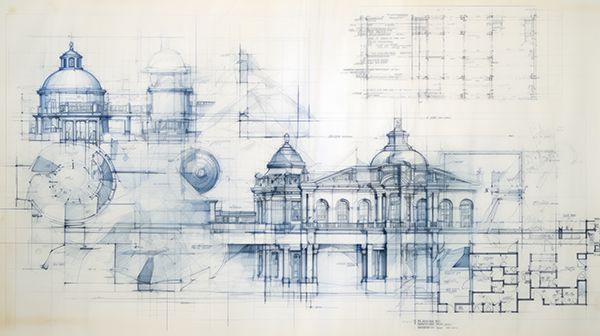SMRT MARKETING:
A resource for Strategic, Measurable, Relational, and Tech-savvy Marketers in Technical Industries.
Engineering Your Industrial Marketing Strategy: 4 Cornerstones for Growth
"Just as a building's cornerstones determine its stability and longevity, there are four foundational elements in industrial marketing that can engineer your brand's success. Let's explore these cornerstones and how they can unlock growth in the competitive industrial landscape."

When I was a kid, my father served in the United States Air Force, and one of his assignments took our family to Scotland. I spent many years there, marveling at the rich history and heritage of the Scottish people. One of my fondest memories is exploring the ancient castles, cathedrals, and churches that dot the landscape. I was always amazed at how these structures, built centuries ago, still stood strong and proud, a testament to the solid foundations upon which they were constructed. More years then I care admit too have passed since I have seen these old architectural wonders, however, as a marketer, I thought it would be fun to draw the parallels between the construction of these enduring monuments and the building of successful brands.

In the world of old architecture, cornerstones were the first stones set in the construction of a building. They were the foundation upon which everything else was built, ensuring stability, alignment, and strength. Similarly, in marketing, there are four foundational elements (cornerstones) that determine the position and effectiveness of all other marketing activities.
Let's delve into these four marketing cornerstones, drawing parallels to their architectural counterparts:
1. The Website: The Digital Storefront
Just as a building's facade is the first impression for visitors, your website serves as the digital storefront of your business. It showcases your expertise and capabilities to a global audience and is often the first point of contact for potential industrial clients seeking solutions. It is where potential customers learn about your offerings, explore your brand, and decide whether to engage further. A well-designed, user-friendly website is essential for establishing credibility and generating leads.
Key considerations for this cornerstone:
- Clear navigation: Ensure engineers, procurement officers, and other decision-makers can easily find the information they need about your products, services, and expertise.
- Compelling content: Highlight your unique value proposition and showcase case studies, white papers, and technical specifications that demonstrate your capabilities.
- Interaction: Incorporate elements like live chat, calculators, or request-for-quote forms to encourage active engagement and facilitate lead generation.
- Mobile responsiveness: Optimize your website for mobile devices, as many industrial professionals access information on the go.
- Call to action: Guide visitors towards contacting your sales team, requesting a demo, or downloading resources, ensuring a seamless path to conversion.

2. The Industrial Customer Avatar: Knowing Your Ideal Occupant
In architecture, understanding the needs and preferences of the building's occupants is crucial for designing a functional and enjoyable space. Similarly, in industrial marketing, creating a detailed customer avatar (a fictional representation of your ideal customer) helps you tailor your messaging and offerings to resonate with your target audience.
Key elements of an industrial customer avatar:
- Demographics: Age, Job titles (e.g., plant manager, engineer, procurement officer), industry, company size, geographic location.
- Psychographics: Pain points (e.g., cost reduction, efficiency improvement, regulatory compliance), challenges, motivations, and values.
- Buying behaviors:
- How they research solutions (e.g., online searches, trade publications, industry events), their decision-making process, and key influencers.
By understanding your ideal industrial buyer, you can create targeted marketing campaigns that speak directly to their needs and drive qualified leads.

3. Brand Identity: The Architectural Style
A building's architectural style reflects its purpose, history, and the values of its creators. Similarly, your brand identity should encompass your brand’s visual aesthetics, personality, and honest values that resonate with industrial buyers. It's the essence of your brand that sets you apart from competitors and creates a lasting impression on your audience.
Key components of brand identity for industrial companies:
• Logo: A strong, recognizable symbol that reflects your industry and expertise.
• Color palette: Evokes specific emotions and associations.
• Typography: Choose fonts that reinforce your brand's personality.
• Voice and tone: Adopt a messaging style that is clear, concise, and focused on technical details and solutions.
• Imagery: Use visuals that showcase your products, services, and facilities in action, highlighting their quality, performance. and value to the customer.

4. The Offering: The Blueprint for Success
In architecture, the blueprint outlines the building's structure, features, and functionality. Similarly, in industrial marketing, your offering (product or service) is the core of your business. It's the solution you provide to meet the specific needs of industrial clients. Your offering should be valuable and aligned with your brand identity.
Key questions to consider for your industrial offering:
- What specific problem does your offering solve?
- How does it deliver tangible benefits to clients (e.g., cost savings, increased efficiency, improved safety)?
- How does it differentiate from competitor offerings in terms of features, performance, or value?
- How will you price and package it to appeal to potential buyers?

Conclusion:
Just as a building's cornerstones determine its stability and longevity, these four marketing cornerstones provide a solid foundation for your industrial brand. By carefully crafting and aligning these elements, you can engineer a marketing strategy that not only attracts loyal customers but also fuels sustainable growth in the competitive industrial landscape and like the old Scottish architecture, will stand the test of time!






